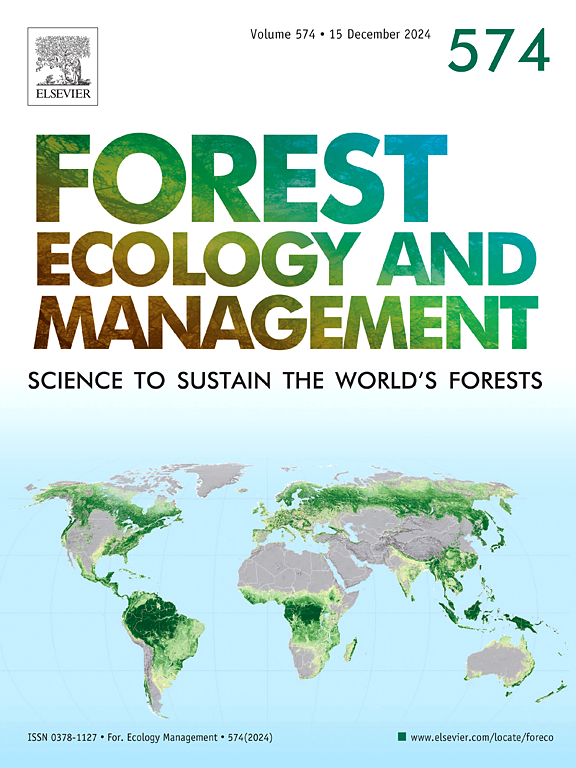Effects of stand structural attributes on oak recruitment in mixed temperate forests
IF 3.7
2区 农林科学
Q1 FORESTRY
引用次数: 0
Abstract
Oak-dominated forests worldwide support high levels of biodiversity and provide many important ecosystem services. However, oak forest sustainability is challenged by unsuccessful recruitment of oaks into the overstory. It is debated whether relatively shade-intolerant oaks can maintain dominance under continuous cover forestry and examples of successful recruitment of oak into the overstory in mixed, uneven-aged forests are rare. This study, set in southern Sweden, investigated the effects of selective cutting on stand structure and oak recruits and how stand density, canopy openness, and a tree species-specific shade casting index relates to the density of oak recruits. We focused on oak recruitment from the lower and middle canopy (dbh 5–10, 10–20 cm), i.e. trees that were beyond browsing height. Our findings indicate that a lower stand density was positively related to recruitment density of the smaller diameter size class, and as an indirect effect that a higher canopy openness with a lower shade-casting index was positively (but not significantly) associated with oak recruitment. Selective cutting decreased stand basal area and stand density while it increased canopy openness, but it did not have a direct short term effect on oak recruitment. These results indicate that stand structures obtained through continuous cover forestry may benefit recruiting oaks and that stand density, canopy openness and a canopy composition with high light transmission may need to be considered when ensuring the continuity of mixed, uneven-aged oak forests.
温带混交林林分结构属性对栎树补充的影响
世界范围内以橡树为主的森林支持着高度的生物多样性,并提供许多重要的生态系统服务。然而,橡树林的可持续性受到了栎树不成功进入林下的挑战。对于相对不耐阴的栎树能否在连续覆盖林下保持优势地位存在争议,并且在混合、年龄不均匀的森林中成功将栎树引入上层的例子很少。本研究以瑞典南部为背景,研究了选择性采伐对林分结构和栎树新生的影响,以及林分密度、冠层开度和树种特异性遮荫指数与栎树新生密度的关系。我们的重点是在树冠下部和中部(胸径5 - 10,10 - 20 cm)招募橡树,即超过浏览高度的树木。研究结果表明,林分密度越低,越有利于小径级栎树的补充密度,而遮荫指数越低的林分开度越高,栎树的补充密度越高。选择性采伐减少了林分基面积和林分密度,增加了林冠开度,但短期内对栎树的补充没有直接影响。这些结果表明,通过连续覆盖获得的林分结构有利于栎树的招募,在保证混交林龄不均匀栎林的连续性时,需要考虑林分密度、冠层开度和具有高透光性的冠层组成。
本文章由计算机程序翻译,如有差异,请以英文原文为准。
求助全文
约1分钟内获得全文
求助全文
来源期刊

Forest Ecology and Management
农林科学-林学
CiteScore
7.50
自引率
10.80%
发文量
665
审稿时长
39 days
期刊介绍:
Forest Ecology and Management publishes scientific articles linking forest ecology with forest management, focusing on the application of biological, ecological and social knowledge to the management and conservation of plantations and natural forests. The scope of the journal includes all forest ecosystems of the world.
A peer-review process ensures the quality and international interest of the manuscripts accepted for publication. The journal encourages communication between scientists in disparate fields who share a common interest in ecology and forest management, bridging the gap between research workers and forest managers.
We encourage submission of papers that will have the strongest interest and value to the Journal''s international readership. Some key features of papers with strong interest include:
1. Clear connections between the ecology and management of forests;
2. Novel ideas or approaches to important challenges in forest ecology and management;
3. Studies that address a population of interest beyond the scale of single research sites, Three key points in the design of forest experiments, Forest Ecology and Management 255 (2008) 2022-2023);
4. Review Articles on timely, important topics. Authors are welcome to contact one of the editors to discuss the suitability of a potential review manuscript.
The Journal encourages proposals for special issues examining important areas of forest ecology and management. Potential guest editors should contact any of the Editors to begin discussions about topics, potential papers, and other details.
 求助内容:
求助内容: 应助结果提醒方式:
应助结果提醒方式:


